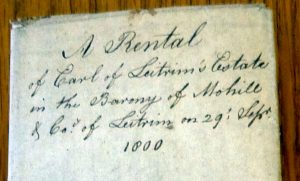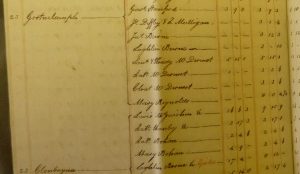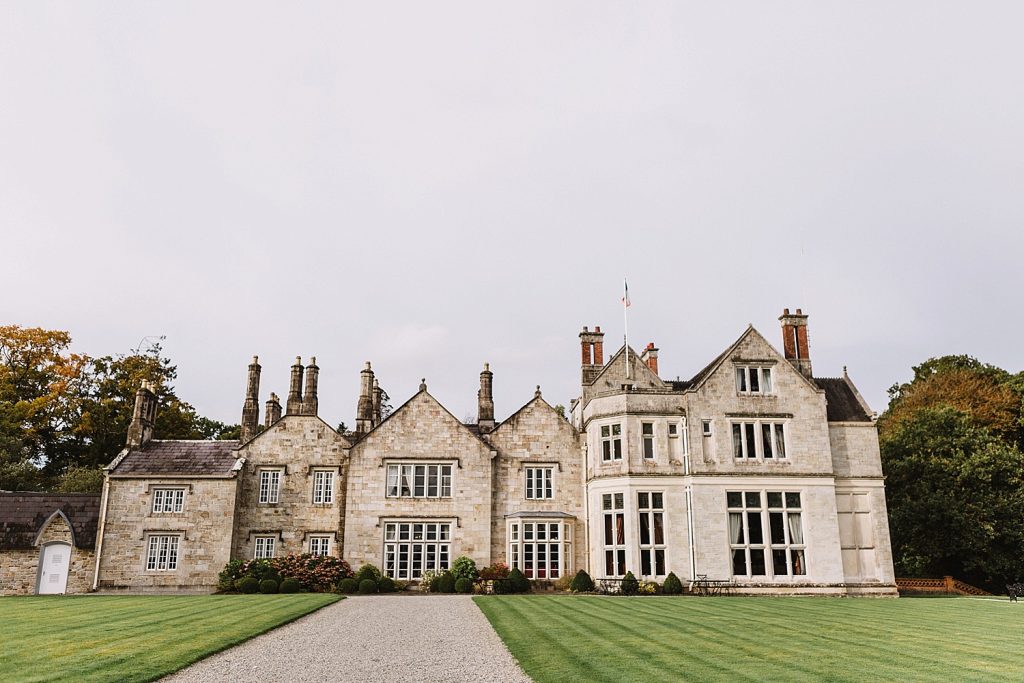One of the many mixed blessings to emerge from the destruction of the Public Record Office in 1922 is the attention that we have been obliged to give to records that are fragmentary, or very local in scope, or just downright peculiar. After almost a century, however, it is hard not to feel that desperation has already forced us into every nook and cranny. There are just a few unexplored frontiers left, and estate papers are probably the most valuable of these.

Between 1700 and 1850 the majority of the population lived as small tenant farmers on large estates owned by English or Anglo-Irish landlords. Inevitably, the administration of these estates produced mouth-watering quantities of paper: maps, tenants’ lists, rentals, account books, lease books and much more. But the records are not systematic, vary enormously in the areas and periods they cover and in their level of detail, and in many cases have simply not survived. Those that have survived are scattered across multiple archives and libraries. As well as Ireland, many of the larger landlords also had holdings in England and Wales, and many records of Irish estates have ended up in English and Welsh archives. Tracking down these surviving records has long been beyond the stamina of all but the most stubborn of researchers.

The Landed Estates website (landedestates.ie), a project of the Moore Institute at NUI Galway, has been a precious beacon of light since 2008, bringing together precise location data, photographs, published material and information on the scope and location of surviving records for estates in Connacht and Munster. The level of detail is exemplary, providing an extrordinary insight into just how interlinked many of the landed families were. The integration with Google maps allows a visualisation of the relative positions of the estates, a good rough guide to an area you’re interested in.
Above all, the project should be providing a wonderful central storage point for all the information emerges in the future. However, nothing has been added for at least five years. What about all those juicy Headfort estate papers in Meath or the wonderful Ulster collection in PRONI?
Yes, the glass is nicely half-full. Please fill it.

Great information, but the landedestates.ie link does not work. Please hurry and fix it! I am so curious!
Dear John,
Thank you for this resource! I’m writing to let you know that the link: landedestates.ie in your blog is broken. When I click on it, the “l” is missing. When I insert the “l” it works.
– Debra
iv been trying to track down the whole family who lived at no 5 shanavalley a tenant farmer of tralee before 1905 and i cannot get a result.
iv been trying to track down the whole family who lived at no 5 shanavalley a tenant farmer of tralee before 1905 and i cannot get a result.
John,
Please know how much your programmatic solution of tying disparate databases together in a single webpage – has helped me to find my ties to Ireland. It goes beyond drinking green beer on St. Paddy’s day.
I cannot explain why something calls to me to know where my families came from, but it does. As an outsider, it takes a bit of time to find your way around Irish customs and ways; and then there is understanding townland, barony, union, and parish. Your website is nothing short of fantastic in presenting the information any of us need to know to find our kin.
Respectfully,
Paul
Thank the Good Lord for the folks @ NUI. May they reawaken & continue the job.
I’ve been to that site before. It has a confusing motif. It looks great at first glance but you soon find yourself circling back and forth between its own links, never seeing substantive information about a particular estate. Eventually I realized there are only a handful of source documents; none are digitised on the site itself; and the site is just a gaudy way of telling you a given estate is mentioned in a particular source. Disappointing.
Hello Mark,
Relating to your comment on the Landed Estates database, I would refer you to the home page of the database which states that the database sets out to be a comprehensive and integrated resource guide to landed estates and historic houses in Connacht and Munster, c. 1700-1914. The aim of the guide is to assist and support researchers working on the social, economic, political and cultural history of these provinces from c.1700 to 1914. In other words, it is highlighting resources for researchers to undertake the work for themselves. At no stage was it indicated that “substantive information” was going to be provided. The most important information the database provides is an indication of the location of primary sources such as estate archives, where it was possible to establish that they were available for researchers to use. Note also that a list of links to secondary sources, now available in digitized format, is available from the home page., under the Contemporary Printed Sources tab.
The Headfords indeed. And the Farnhams too. I have been trying for years to pinpoint the ultimate landlord of my Cavan family (Farrelly). Its quite had to sift through the middlemen to find out who ultimately owned the tenant’s land. Any advice?
I did discover that the nearby estate went up on the auction block after the famine thanks to the Encumbered Estate Act. I found out about that from a newspaper ad, thanks to FMP.
But is there a listing or record anywhere of who owned what parcels of land by county? Or anything?
John When you look back at all your posts I’m wondering how you would feel about publishing a book of all – or the best – etc. I love your writing. Please consider this.